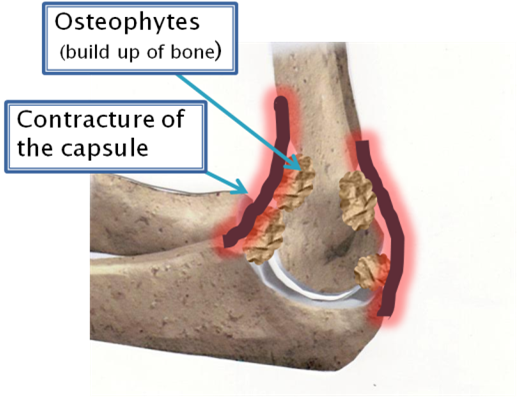Stiff elbow
Elbow stiffness is common and can develop after an injury, after surgery, or because of arthritis. The elbow is a complex of three joints that allows you to bend, straighten, and rotate the forearm. The elbow allows you position the hand for all daily activities. Elbow stiffness can even affect your ability to do simple things such as brush your teeth, comb your hair, or feed yourself.
Elbow stiffness can be caused by changes in the bone or the soft tissues surrounding the joint. The cause can be trivial such as minor injury causing a contracture of the capsule which surrounds the joint. Broken bones with the fracture extending into the joint surface is a common cause. Arthritis will also limit the range of motion.

What is the non operative treatment?
The goal of stiff elbow treatment is to restore pain-free motion that improves function. Non-operative measures to treat elbow stiffness include physiotherapy for range of motion exercises and stretching. Sometimes a splint can be made that will slowly help straighten or bend your arm over time.
What are the surgical options?
Surgery may be necessary if the symptoms fail to improve with these conservative measures. The operation may require release of the joint capsule or covering, release of scarred muscle or ligaments, removal of abnormal bone or joint contents, and possibly release of nerves if they are tight or involved in scar. This will usually be performed using arthroscopic or minimally-invasive surgery in which small instruments are introduced into the elbow joint through the skin and a camera is used to guide the surgery. Recovery from this type of surgery is quicker, but patients who have had previous surgery or have extensive bone abnormality are not suitable for keyhole surgery.
Post operative physiotherapy is critical in the treatment of elbow stiffness. The elbow will usually fully straighten and flex at the end of the operation. However this must be maintained with agressive physiotherapy. If the elbow is allowed to rest for even a few days the soft tissues and scar tissue will return and the joint will once more become stiff. Regular pain killers should be taken so that the elbow can be stretched to its maximum range of movement possable. Dispite analgesia this can be painful, however it is safe to continue to stretch the joint as no harm is being done. Indeed imobility is the enemy!.
Sometimes after a major debridement for an arthritic elbow a continuous infusion of pain killer is fed through a cannula to the nerves which provide feeling to the elbow. This leaves the arm numb for 48 hours and facilitated early pain free range of motion.




